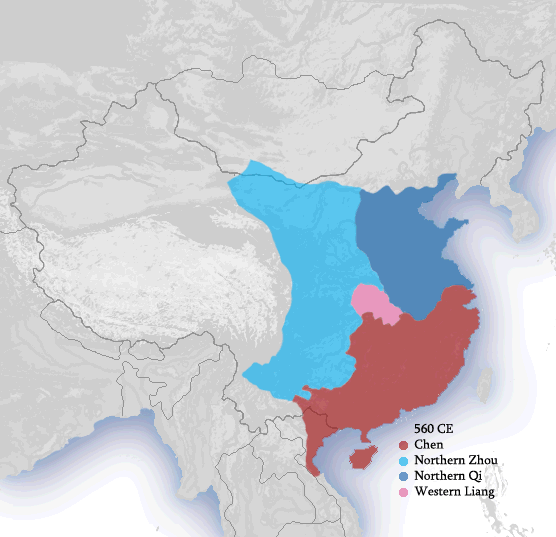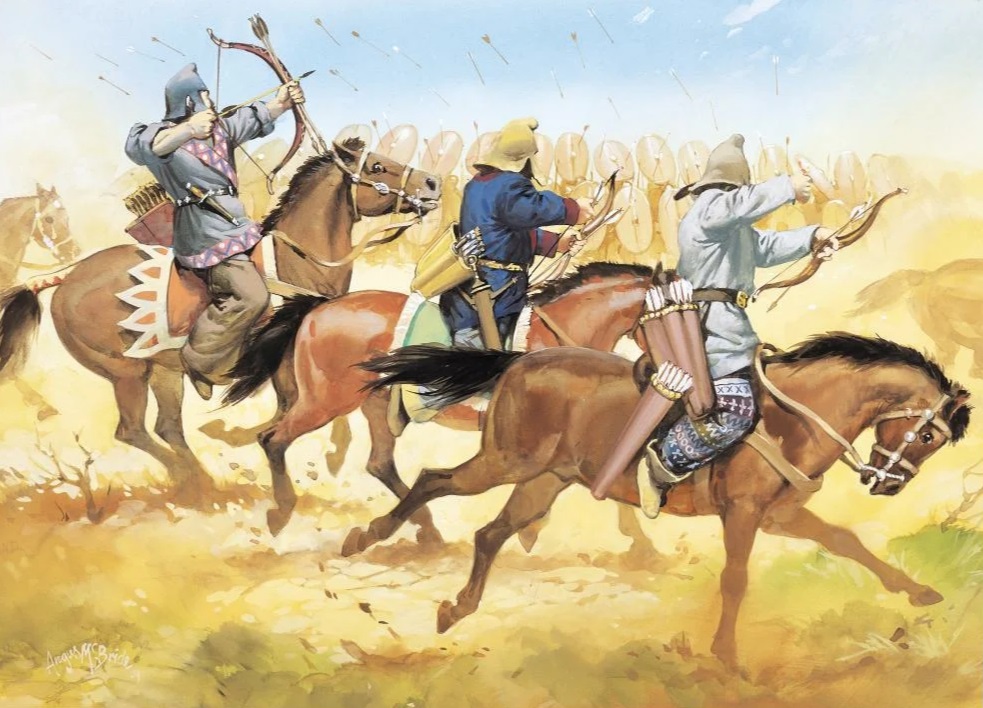The appearance of the Turkic Khaganate in the middle of the sixth century seriously changed the balance of power in Central and East Asia. The Chinese and the Ephthalites had a powerful rival who also claimed hegemony in the region.
The initial success of the Turks in their conquests was facilitated by the fact that in 553 the northern Chinese state of Bei Qi defeated the Khitans. Those had to submit to the Turks and the latter went to the Yellow Sea. Thus, the Turks covered all the northern borders of Northern China and were now free to maneuver within these limits.
At the same time, in this North Chinese state and neighboring Bei Zhou, a confrontation began between local Chinese nationalists and the military nobility, who originated from the Xianbians (proto-Mongol tribes).

A sketch of Xianbian life
The nationalists won in Bei Qi, and the Xianbian nobility won in Bei Zhou
A confrontation began between the two Chinese states and in 561 ambassadors were sent from both kingdoms to the Turks with an offer of the hand of Chinese princesses and an alliance.
The Turkic ruler Mugan Khan preferred his close relatives in the lifestyle of Bei Zhou.
For several years, the Turks, along with the army of Bei Zhou, devastated the territory of Bei Qi. The Turks did not strive for the complete destruction of Bei Qi, as it was not profitable for them. They robbed Bei Qi, and Bei Zhou paid 100,000 pieces of silk each year for his help in the campaigns. Eventually, the Bei Qi began to pay the same amount of silk.
Thus, both North Chinese states became vassals of the Turks. And the silk they sent enriched the Turkic nobility.
But there was so much silk that it had to be sold somewhere. It could only be implemented in Byzantium, which was an intermediary in trade between China and Europe.
At that time, the Turks, under the leadership of Istemi Khan, reached the Volga. Then there were the possessions of the remnants of the Hunnic union — the Kuturgurs and the Utigurs. Beyond them lay the lands of the Alans, the Ants, and the Sabirs.

Istemi Bahadur-yabgu is the younger brother of Bumyn Kagan from the Ashina dynasty, yabgu (the second person in the state) From 552[1] to 576, he led the Western policy of the khaganate for twenty years and was almost an independent ruler of the western territories. Thanks to Istemi, the Turks took control of the Great Silk Road, established close relations with Iran and Byzantium, destroyed the Ephthalite state and expanded the borders of the khaganate to the Black Sea.
A fratricidal war was going on between these two fraternal peoples. The Utigurs who lived in the Kuban were for the Byzantines, and the Kuturgurs attacked the Greeks.
Under the onslaught of the Turks, the Avars came to the lands of these peoples — a combined tribe from the Iranian-speaking Huni and Vara tribes. They were able to gain a foothold here and gradually began to gain strength to finally become the Avar khaganate.
And the Turks turned their horses from the Volga to the lands of the Parthians. They needed to conquer them in order to transport silk to Iran and further to Byzantium without hindrance.
In 568, the Avars became allies of the enemies of the Greeks, Iran. They defeated the Ants, the Utigurs and the Sabirs. The Avars became the hegemons of the region. Then the Avars defeated the Kuturgurs who were fighting with the Greeks and went to the Danube. The Avar Khaganate was founded here, which concluded a peace treaty with the Byzantine Empire in 572.
At the same time, the Turks and Persians defeated the Ephthalite state. In 565, the Ephthalites were finally defeated near the city of Nisef. Maveranakhr became Turkic.
After that, a Sogdian merchant in the Turkic service, Maniyah, tried to establish trade in Turkic silk through Iran. But the Persians did not want this, because they were afraid that the Turks and Greeks would gain strength through this trade. Therefore, the Persians bought all the silk from Maniachus and burned it. It was certainly blasphemous!
Maniachus had to go to Byzantium, having had a hard time with the Persians, in order to negotiate a transit trade in silk there.

The image of Maniachus on the fresco
In 568, Maniachus negotiated an alliance between the Greeks and the Turks.
In 569, the Turks attacked Iran, defeating its army. But the Greeks did not enter the war without fulfilling their promises. And the Persians were able to transfer troops from the western borders to the Gurgan wall in the border area with the Turks. That’s where the Turks stopped.
Then the Turks directed the main attack to the Caucasus, where they were able to break through to the Taman Peninsula and came into direct contact with the Greeks in the Crimea.
But the fact that the Greeks did not join the war offended the Turks very much. They were no longer eager to be their allies.
And in 576, the Turks tried to break through to the Bosporus and Georgia, allied to the Greeks. Meanwhile, in the east, Turkic men-at-arms under the leadership of Tobo Khan participate in the war against the Zhou kingdom and smash it, forcing peace and payment of tribute in silk.

Northern Zhou is a Tobas state of the period of the Northern and Southern dynasties in Northern China in 557-581. It arose on the site of the state of Western Wei. Subsequently, he was replaced here by the Sui Dynasty.
In 581, the Turks concluded a peace treaty with Byzantium, and the Sui Dynasty would replace the Northern Zhou, which would unite all of China — both Northern and Southern. The Sui emperors will be extremely hostile to the Turks and all nomads in general.
Thus, by 581, the Turks had become the strongest empire between Byzantium and China.
The Great El Turki was formed, where the interests of the warriors, who became the backbone of the state, were put at the forefront. Squads of warriors were recruited from various tribes and they did not carry any duty except military service. All the others paid taxes to the kagan’s treasury. And the taxes were very heavy. Therefore, only with the help of military force could the Kagan retain power over a vast territory and stop separatism.
